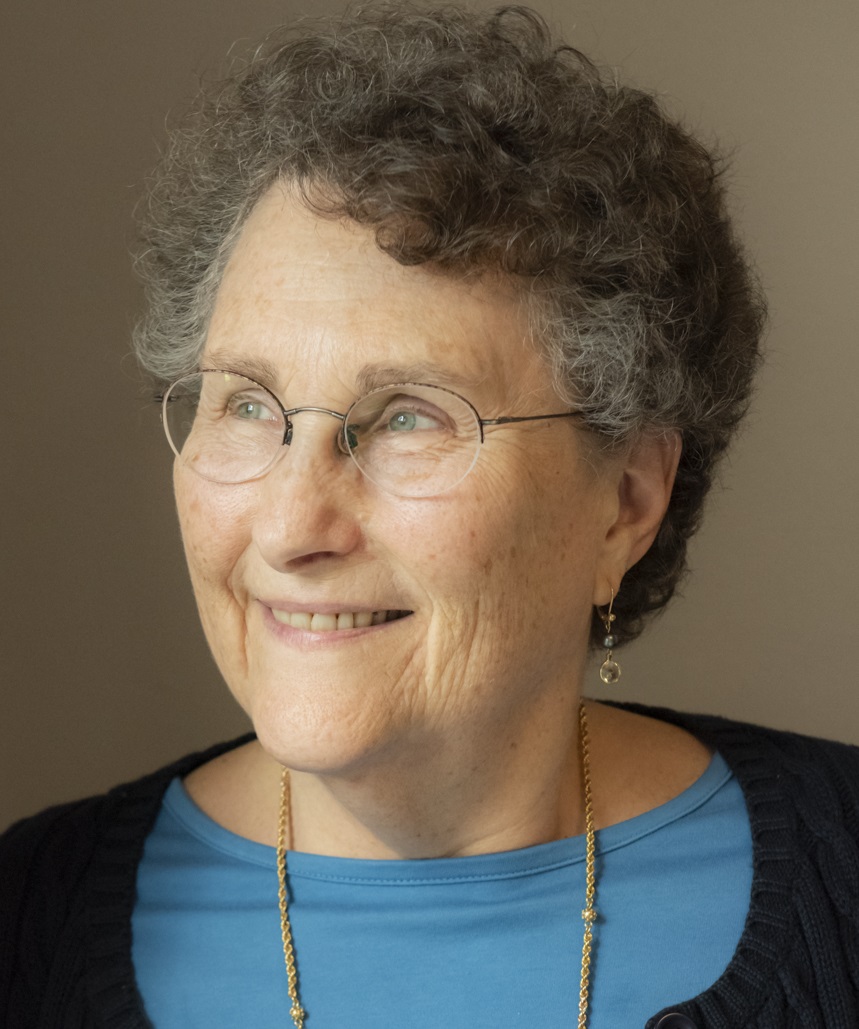Draw near: Desire
Lynne Baab • Tuesday November 29 2022

“In the modern period and in Europe and America, we’ve tended to think of religions in terms of belief. That means cognitive assent, cognitive understanding. . . . But most human beings don’t live in that kind of modern, somewhat sterile world. We’re always oriented to our desires. Whether they’re simple desires like ‘I’m thirsty or hungry,’ or whether they’re a desire to see a beloved child or lover, our whole life is about desire. A lot of hymns capture this more affective, aesthetic, openhearted way of experiencing our life and our faith. . . . [Desire] is the openness of the heart and the heart’s effort to find what is most appropriate to it now.”
—Professor Wendy Farley, Graduate School of Theology, University of Redlands [1]
A couple of months ago I wrote about trying to find one word to capture what I want to pray for for friends and family members. As I use my imagination to try to figure out that one word, I am also trying to access my desire for them. Sometimes my desire for people I love is intense: protection for my granddaughter, joy for a friend who often seems down, peace for my mother at 98. So I pray those words with that person’s face in my mind: protection, joy, peace. I’d never thought about these prayers as related to desire. Dr. Farley’s words helped me see some of the ways my desires shape my prayers for friends and family members.
Dr. Farley goes on to say that in our culture we associate desire with consumer desire. “The whole consumer culture is about inflaming desire for things you can buy and building our identity around those things.” She says that desire that is rooted in faith is different. “It’s not about possessing something. It’s not a religious form of consumerism where you think, ‘Oh, if only I get this holy thing, I will be okay.’ It’s opening your heart to a relationship, which is not structured by possession but by love.”
I am quite sure that my deep love for Christian music, both hymns and praise songs, is rooted in the way that words joined with music help me express my desire for a relationship with God and also help me say words of love to God. This is probably most vivid in my post about praying to Jesus our priceless treasure, based on a powerful hymn.
Desire has had a bad rap off and on throughout Christian history. Some theologians have argued that if we are totally sinful without Christ, then our desires must be wholly evil. That view ignores two things: (1) the beauty of God’s image put in us at creation and (2) the way God’s Spirit transforms us into the image of Christ over months and years as we walk with Jesus. Evaluating our desires, then, requires discernment. Is the desire I’m feeling something that connects me to God’s heart for the people in my life and God’s work of transformation in me? Then my desires can fuel my prayers.
Dr. Farley talks about routing desire in the right direction. We can ask God to guide our desires. In addition, she urges us to ponder the way love relates to a desire for others’ wellbeing:
“I don’t love a person because they’ll make me feel better. I love a person because I think they’re precious. I crave their well-being. I can love the Earth – not as a resource, but I love its raw beauty. I am therefore provoked to want to care for it. . . . It’s this deep enjoyment of a beloved and a deep desire for their well-being.”
“I crave their well-being” makes me wonder how I can nurture more passion for the people and things I love so that my prayers can be empowered by that energy.
Dr. Farley makes an additional argument about the way relinquishing the desire to possess connects us to love. She argues that our love for God is “an abandonment to not knowing, to not controlling. Simone Weil says beauty is what we love without wanting to eat it. And that’s what this holy desire is: desire that is liberated from the craving to possess.”
Dr. Farley has used the vivid word “craving” in two ways. When I love a person, she says, “I crave their well-being.” At the same time, holy desire is “liberated from the craving to possess.” These kinds of desires are a powerful source of energy for prayer. May God help you identify the ways your desires are connected to love and relationship, and may the Holy Spirit guide you into the kind of holy desires that honor God’s intention and work in your life so that you can pray with energy and passion.
(Next week: Prayer during Advent. Illustration by Dave Baab: a full size model at SeaTac airport of The Global Voyager, which was the first plane to fly around the world non-stop in 1984. If you’d like to receive an email when I post on this blog sign up below under “subscribe.”)
Some related posts:
- Drawing near to God with the heart: What do you want?
- Henri Nouwen on being beloved
- Creative prayer: Relinquishing and welcoming
[1] All quotations in this article come from “Thinking about God’s Desire with the Medieval Mystics,” interview of Professor Wendy Farley by Amy Frykholm, The Christian Century, June 15, 2022, pages 32-34.
Next post »« Previous post
Subscribe to updates
To receive an email alert when a new post is published, simply enter your email address below.

Lynne M. Baab, Ph.D., is a teacher and writer. She has written numerous books, Bible study guides, and articles for magazines and journals. Lynne is passionate about prayer and other ways to draw near to God, and her writing conveys encouragement for readers to be their authentic selves before God. She encourages experimentation and lightness in Christians spiritual practices. Read more »
Lynne is pleased to announce the release of her book on grief and gratitude, designed to help people grieving from anything, including the pandemic, while also desiring to notice God's good gifts. Two Hands: Grief and Gratitude in the Christian Life is available in paperback, audiobook, and for kindle. Lynne's 2018 book is Nurturing Hope: Christian Pastoral Care for the Twenty-First Century, and her best-selling book is Sabbath-Keeping: Finding Freedom in the Rhythms of Rest (now available as an audiobook as well as paperback and kindle). You can see her many other book titles here, along with her Bible study guides.
Lynne recently spoke about empathy and also about bringing spiritual practices to life.
Lynne was interviewed recently for the podcast "As the Crow Flies". The first episode focuses on why listening matters and the second one on listening skills.
Here are two talks Lynne gave on listening (recorded in audio form on YouTube): Listening for Mission and Ministry and Why Listening Matters for Mission and Ministry.
"Lynne's writing is beautiful. Her tone has such a note of hope and excitement about growth. It is gentle and affirming."
— a reader
"Dear Dr. Baab, You changed my life. It is only through God’s gift of the sabbath that I feel in my heart and soul that God loves me apart from anything I do."
— a reader of Sabbath Keeping
Subscribe
To receive an email alert when a new post is published, simply enter your email address below.
Featured posts
- Drawing Near to God with the Heart: first post of a series »
- Quotations I love: Henri Nouwen on being beloved »
- Worshipping God the Creator: the first post of a series »
- Sabbath Keeping a decade later: the first post of a series »
- Benedictine spirituality: the first post of a series »
- Celtic Christianity: the first post of a series »
- Holy Listening »
- A Cat with a Noble Character »
- Welcome to my website »
Tags
Archive
- April 2024 (4)
-
March 2024 (5)
- Friendship, loneliness, and prayer: Praying about distractions from empathy
- Friendship, loneliness, and prayer: Praying to keep empathy flowing
- Friendship, loneliness, and prayer: Everyday initiative
- Friendship, loneliness, and prayer: Praying for guidance for ending conversations
- Friendship, loneliness, and prayer: Reflecting on the series
- February 2024 (4)
- January 2024 (2)
-
December 2023 (6)
- Friendship, loneliness, and prayer: Initiating
- Friendship, loneliness, and prayer: Praying about listening roadblocks
- Friendship, loneliness, and prayer: Praying to love the poverty in our friends
- Friendship, loneliness, and prayer: Praying for “holy curiosity”
- Friendship, loneliness, and prayer: Praying for “holy listening”
- Friendship, loneliness, and prayer: Praying to give affection extravagantly
- November 2023 (4)
-
October 2023 (5)
- Friendship, loneliness and prayer: A listening skill with two purposes
- Friendship, loneliness, and prayer: Saying “thank you” to friends
- Friendship, loneliness, and prayer: One more way reflecting helps us
- Friendship, loneliness, and prayer: Lessons from two periods of loneliness
- Friendship, loneliness, and prayer: Types of reflecting, a listening skill
- September 2023 (4)
- August 2023 (4)
- July 2023 (5)
- June 2023 (3)
- May 2023 (6)
- April 2023 (4)
- March 2023 (4)
- February 2023 (4)
- January 2023 (4)
- December 2022 (5)
- November 2022 (1)
- October 2022 (5)
- September 2022 (5)
-
August 2022 (6)
- Draw near: Confessing sin without wallowing
- Draw near: A favorite prayer about peace, freedom, and much more
- Drawing near with Desmond Tutu: God’s love is the foundation for prayer
- Draw near: Worshipping God with Desmond Tutu
- Draw near: Yearning, beseeching and beholding with Desmond Tutu
- Draw near: Praising God with Desmond Tutu
- July 2022 (2)
- June 2022 (6)
- May 2022 (5)
- April 2022 (6)
- March 2022 (5)
- February 2022 (4)
- January 2022 (3)
- December 2021 (5)
- November 2021 (4)
- October 2021 (5)
- September 2021 (4)
- August 2021 (4)
- July 2021 (4)
- June 2021 (4)
- May 2021 (4)
- April 2021 (5)
- March 2021 (4)
- February 2021 (4)
- January 2021 (4)
- December 2020 (5)
- November 2020 (3)
- October 2020 (5)
- September 2020 (4)
- August 2020 (4)
- July 2020 (5)
- June 2020 (4)
-
May 2020 (4)
- Spiritual diary of sheltering in place: The lifeline of separating thoughts from feelings
- Spiritual diary of sheltering in place: The lifeline of welcoming prayer
- Spiritual diary of sheltering in place: a kite string as a lifeline
- Spiritual diary of sheltering in place: The lifeline of God’s distant future
-
April 2020 (7)
- Spiritual diary of self-isolation: the lifeline of God’s constancy
- Spiritual diary of sheltering in place: The lifeline of accepting my place as a clay jar
- Spiritual diary of sheltering in place: the lifeline of memories
- Spiritual diary of sheltering in place: the lifeline of “Good” in “Good Friday”
- Spiritual diary of sheltering in place: The lifeline of “easier does not mean easy”
- Spiritual diary of sheltering in place: The lifeline of nature
- Spiritual diary of sheltering in place: the lifeline of God’s voice through the Bible
-
March 2020 (7)
- Important anniversaries in 2020: The first Earth Day in 1970
- Important anniversaries in 2020: Florence Nightingale was born in 1820
- Spiritual diary of self-isolation: Weeks 1 and 2
- Spiritual diary of self-isolation: God's grace as a lifeline
- Spiritual diary of self-isolation: The lifeline of limits on thoughts
- Spiritual diary of self-isolation: Wrestling with God for a blessing
- Spiritual diary of self-isolation: responding to terror by listening to Jesus voice
- February 2020 (4)
- January 2020 (5)
- December 2019 (4)
- November 2019 (4)
- October 2019 (5)
- September 2019 (4)
- August 2019 (5)
- July 2019 (4)
- June 2019 (4)
- May 2019 (5)
- April 2019 (4)
- March 2019 (4)
- February 2019 (4)
-
January 2019 (5)
- Nurturing friendships in a cellphone world: Jesus as Friend
- Nurturing friendships in a cellphone world: Friendship with Christ and friendship with others
- Nurturing friendships in a cellphone world: Who is my neighbor?
- Nurturing friendships in a cellphone world: Friendship as action
- Nurturing friendships in a cellphone world: Hymns that describe friendship with God
- December 2018 (3)
-
November 2018 (5)
- Connections between the Bible and prayer: Sensory prayer in Revelation
- First post in a new series: Nurturing friendships in a cellphone world
- Nurturing friendships in a cellphone world: Strong opinions and responses
- Nurturing friendships in a cellphone world: My conversation partners about friendship
- Nurturing friendships in a cellphone world: Two views about communication technologies
- October 2018 (4)
- September 2018 (4)
-
August 2018 (5)
- Providing Christian Care in Our Time
- Providing Christian care in our time: Seven trends in pastoral care today
- Providing Christian Care in Our Time: Skills for Pastoral Care
- Providing Christian care: The importance of spiritual practices
- First post in a new series: Connections between the Bible and prayer
- July 2018 (4)
- June 2018 (4)
- May 2018 (5)
- April 2018 (4)
- March 2018 (5)
- February 2018 (4)
- January 2018 (4)
- December 2017 (5)
- November 2017 (4)
- October 2017 (4)
- September 2017 (5)
- August 2017 (4)
- July 2017 (4)
- June 2017 (4)
-
May 2017 (5)
- My new spiritual practice: Separating thoughts from feelings
- My new spiritual practice: Feeling the feelings
- My new spiritual practice: Coping with feelings that want to dominate
- My new spiritual practice: Dealing with “demonic” thoughts
- My new spiritual practice: Is self-compassion really appropriate for Christians?
- April 2017 (4)
- March 2017 (5)
- February 2017 (4)
- January 2017 (4)
- December 2016 (5)
- November 2016 (4)
- October 2016 (4)
- September 2016 (5)
- August 2016 (4)
- July 2016 (4)
- June 2016 (4)
- May 2016 (5)
- April 2016 (4)
- March 2016 (5)
- February 2016 (4)
- January 2016 (4)
- December 2015 (4)
- November 2015 (4)
- October 2015 (5)
- September 2015 (4)
- August 2015 (4)
- July 2015 (4)
- June 2015 (4)
- May 2015 (4)
- April 2015 (6)
- March 2015 (4)
- February 2015 (4)
- January 2015 (4)
- December 2014 (5)
- November 2014 (4)
- October 2014 (4)
- September 2014 (4)
- August 2014 (5)
- July 2014 (4)
- June 2014 (7)





















